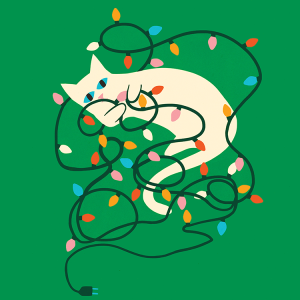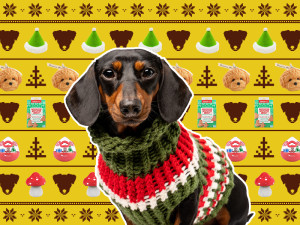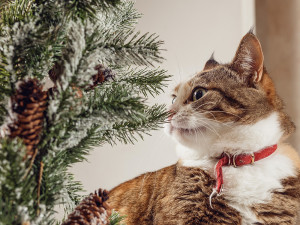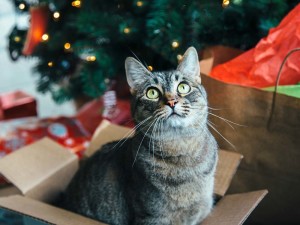8 Holiday Hazards That May Be Fun For You But Not Your Pet
Tips for keeping your pet merry this season.

share article

Your pet wants you to read our newsletter. (Then give them a treat.)
As the holiday season gears up, have you noticed that with the increase in fun and festivities comes a simultaneous increase in the level of pet mischief? There just seems to be no way for curious dogs and cats to resist the allure of all that shiny holiday stuff. Creating a pet-safe environment ensures that both you and your pal can enjoy the holidays worry-free. Here’s a checklist (all naughty, no nice!) of the common holiday hazards for pets to help keep your pet out of the emergency room.
1. Holiday lights
Decorative lights on the tree can pose a serious electrocution hazard when chewed by dogs. Signs of electric shock range from a dazed and confused behavior to difficulty breathing, burn injuries in the mouth, seizuresopens in a new tab, and potentially sudden death. Immediate evaluation by a veterinarian is recommended if you suspect electrocution. Take appropriate precautions to ensure lights are hung out of reach, and the cord is adequately protected. Use grounded three-prong extension cords and strictly follow the manufacturer’s guidelines for light usage.
2. Tinsel and ribbons
Tinsel and ribbon can potentially obstruct the intestines when ingested. In medical terms, we refer to these items as “linear foreign bodies.” They have significant potential to get bound up within the intestinal tract causing a blockage and, in some cases, cutting through the intestines.
These linear foreign bodies often get “hung up” in the intestines, causing deadly “bunching,” and can only be removed by surgical means. If you notice a bit of ribbon, tinsel, or string, whether from the mouth or the other end (err, out of their rump), it is important to remember never cut the ribbon or attempt to remove it yourself. Seek veterinary care immediately.
Vomitingopens in a new tab, diarrheaopens in a new tab, loss of appetiteopens in a new tab, and depressionopens in a new tab are the most common abnormalities seen when an intestinal obstruction develops, and early surgical care is essential. Exercise extreme caution and never leave pets unattended around string, tinsel, and ribbon.
3. Christmas ornaments
Ornaments may be ingested and have the potential to cause an obstruction leading to the need for surgery. Ornaments made of glass can fall and break, leading to cutsopens in a new tab and other injuries. Adequately secure ornaments and place them above the reach of wandering paws and curious noses.
4. Christmas trees
Tree-stand water contains preservatives and sap that may cause vomiting and diarrhea. In addition to the water, pine needles can irritate the esophagus and may cause vomiting, diarrhea, lethargy, trembling, and weakness.
5. Toxic holiday plants
Festive plants are often displayed during the holidays, and precautions should be taken to avoid ingestion of any plant. Even “non-toxic” plant material, such as pine needles, may cause stomach upset. Common holiday plants to take particular note of include:
Lilies are extremely toxic to cats.
Ingestion of any part of the lily plant, even in small amounts, can cause life-threatening toxicity in catsopens in a new tab. Early signs include lethargy and vomiting. Without prompt treatment, most cats will become extremely ill and develop kidney failure within 36 to 48 hours of ingestion.
Amaryllis is toxic to both dogs and cats.
Also known as belladonna-lily, this plant often causes vomiting, diarrhea, and belly pain in cats and dogs. It can also cause more serious problems, including low blood pressure and liver damage.
Poinsettia plants are considered to be mildly toxic to pets.
Poinsettiasopens in a new tab often only causes mild stomach upset and/or skin irritation in pets. Treatment is recommended only if any clinical signs develop. Research estimates that the average animal would have to ingest 500 to 600 poinsettia leaves to surpass toxic levels. The most common symptom is irritation to the mouth and stomach, which sometimes causes vomiting.
Mistletoe contains a variety of potential toxins.
Mistletoe and holly species can cause serious poisonings, though this is less common. Clinical signs of mistletoe poisoning in dogs are usually limited to salivation, vomiting, and diarrhea. Other symptoms of mistletoe ingestion include gastrointestinal disorders, cardiovascular collapse, dyspnea, bradycardia, erratic behavior, vomiting, diarrhea, and low blood pressure.
6. Potpourri
Potpourri is often used around the house to put us in the holiday mood. The plant material and some additives are very irritating to the skin, mouth, and intestinal tract. If skin exposure is suspected, then bathing with a mild soap is recommended, and medical care may be needed to treat irritation and pain that follow exposure. Ingestion often results in signs that may include drooling, loss of appetite, vomiting, and in some cases, disorientation.
7. Hazardous treats
Treats are a common source of holiday emergencies. While it can be hard to resist your pleading pet’s eyes, it is important to recognize the dangers of particular foods and treats.
Bones expose your pets to many unnecessary risks, including the potential for choking or developing an obstruction in their intestinal tract. Cooked bones, when chewed, can fragment into tiny slivers that can cause severe irritation to the intestinal tract as they pass. Rawhidesopens in a new tab and bully sticks have the potential to cause choking and intestinal obstruction.
8. Toxic foods
“People foods” that we take for granted as being safe for us are not always safe for pets, in fact, some foods are downright toxic to dogsopens in a new tab and catsopens in a new tab.
Raisins and grapes have been implicated in causing kidney failure in dogs.
Onion ingestion can cause blood cell damage in both dogs and cats.
Chocolate contains caffeine and a caffeine-like substance (theobromine) that is toxic to dogs and cats.
Macadamia nuts cause dogs to show a variety of strange neurological signs that can include weakness, apparent pain, disorientation, and tremors.
Fatty foods such as meat trimmings are common culprits for causing stomach upset, vomiting, diarrhea and pancreatitisopens in a new tab.

Dr. Shea Cox, DVM, CVPP, CHPV
Dr. Shea Cox is the founder of BluePearl Pet Hospice and is a global leader in animal hospice and palliative care. With a focus on technology, innovation and education, her efforts are changing the end-of-life landscape in veterinary medicine.
Related articles
![dog stocking stuffers with holiday background]() opens in a new tab
opens in a new tabStocking Stuffers For Good Doggos
Bichon-shaped candles, tiny holiday hats, cowboy Corgi ornaments, and more gifts guaranteed to squish into oversized decorative socks.
![Cat playing with Christmas tree]() opens in a new tab
opens in a new tabA Cat-Safe Christmas Tree Doesn’t Exi...
The Sill’s “holiday cactus” is actually less prickly than a pine.
![Dog waiting for a Christmas biscuit]() opens in a new tab
opens in a new tab10 Festive Dog Treats to Make the Holidays Your Pup’s Favorite Time of Year
From pumpkin spice and peppermint to turkey and yams, these sweet and savory treats will delight any dog.
![Tabby cat in a box under the Christmas tree]() opens in a new tab
opens in a new tabOde to an Empty Cardboard Box
The gift that keeps on giving.
![a dog by biscuits and a Christmas tree]() opens in a new tab
opens in a new tabThe Holidays Are Prime Time for Pancreatitis—Here’s How to Protect Your Dog
With all the festivities (and eating!) afoot, it’s extra important to know how to prevent the disease.






